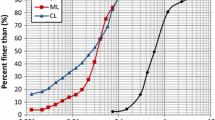Abstract
Oil pollution in soils is an important problem for foundations, excavations, and slopes. Soil contamination occurs when oil leaks from storages, pipelines, petrochemical activities, etc. for so many reasons. This pollution changes geotechnical properties of soils. Researchers have tested different types of soil to assess their behavior once oil-contaminated. However, to the best of our knowledge, no study on oil-contaminated collapsible soil is published. Accordingly, the present study is an attempt to test collapse potential of these soils. Samples were tested in different saturation conditions. Saturated tests were carried out on clean soil with water, gas oil or lamp oil as pore fluid, separately. Another series of samples were partially contaminated with gas oil or lamp oil and saturated with water. Results showed that, with disturbing loess soils, collapse potential decreases even though the samples were remolded at the same void ratio as that of undisturbed samples. Saturating the samples with gas oil and lamp oil virtually disappeared collapse potential and made it to a very slight value. The samples contaminated with different gas oil and lamp oil contents showed an increase in collapse potential with increasing oil content.












Similar content being viewed by others
References
ASTM-D2166 (2006) Standard test method for unconfined compressive strength of cohesive soil. ASTM (American Society for Testing and Materials), West Conshohocken, PA
ASTM-D2487 (2011) Standard practice for classification of soils for engineering purposes (Unified Soil Classification System). ASTM (American Society for Testing and Materials), West Conshohocken, PA
ASTM-D422 (2007) Standard test methods for particle-size analysis of soils. ASTM (American Society for Testing and Materials), West Conshohocken, PA
ASTM-D4318 (2000) Standard test methods for liquid limit, plastic limit, and plasticity index of soils. ASTM (American Society for Testing and Materials), West Conshohocken, PA
ASTM-D5333 (2003) Standard test methods for measurement of collapse potential of soils. ASTM (American Society for Testing and Materials), West Conshohocken, PA
ASTM-D854 (2014) Standard test methods for specific gravity of soil solids by water pycnometer. ASTM (American Society for Testing and Materials), West Conshohocken, PA
Clemence SP, Finbarr AO (1981) Design considerations for collapsible soils. J Geotech Eng Div ASCE 107(3):305–317
Cook EE, Puri VK, Shin EC (1992) Geotechnical characteristics of crude oil-contaminated sands. In: Proceedings of the 2nd international offshore polar engineering conference, San Francisco, USA, pp 384–387
DiMatteo L, Bigotti F, Ricco R (2011) Compressibility of kaolinitic clay contaminated by ethanol–gasoline blends. J Geotech Geoenviron Eng 137:846–849
Hosseini MA (2014) Stabilization and improvement of collapsible soils, using electrokinetics & nanomaterials and assessment its strength parameters by unsaturated oedometer. M.Sc. thesis, Sharif University of Technology, Tehran, Iran
Kermani M, Ebadi T (2012) The effect of oil contamination on the geotechnical properties of fine-grained soils. Soil Sediment Contam 21:655–671
Khamehchiyan M, Hossein Charkhabi A, Tajik M (2007) Effects of crude oil contamination on geotechnical properties of clayey and sandy soils. Eng Geol 89:220–229
Khosravi E, Ghasemzadeh H, Sabour M, Yazdani H (2013) Geotechnical properties of gas oil-contaminated kaolinite. Eng Geol. https://doi.org/10.1016/j.enggeo.2013.08.004
Meegoda N, Ratnaweera P (1994) Compressibility of contaminated fine-grained soils. Geotech Test J 17:101–113
Nasr A (2013) Uplift behavior of vertical piles embedded in oil-contaminated sand. J Geotech Geoenviron Eng 139:162–174
Peck RB, Hanson WE, Thornburn TH (1974) Foundation engineering, 2nd edn. Wiley, New York
Shin EC, Das BM (2001) Bearing capacity of unsaturated oil-contaminated sand. Int J offshore polar Eng 11(03)
Singh SK, Srivastava RK, John S (2008) Settlement characteristics of clayey soils contaminated with petroleum hydrocarbons. Soil Sediment Contam 17:290–300
Skempton AW, Jones OT (1944) Notes on the compressibility of clays. J Geol Soc 100:119–135
Ur-Rehman H, Abduljauwad SN, Akram T (2007) Geotechnical behavior of oil-contaminated fine-grained soils. Electron J Geotech Eng 12A:15–23
Author information
Authors and Affiliations
Corresponding author
Additional information
Publisher's Note
Springer Nature remains neutral with regard to jurisdictional claims in published maps and institutional affiliations.
Rights and permissions
About this article
Cite this article
Nokande, S., Khodabandeh, M.A., Hosseini, S.S. et al. Collapse Potential of Oil-Contaminated Loessial Soil (Case Study: Golestan, Iran). Geotech Geol Eng 38, 255–264 (2020). https://doi.org/10.1007/s10706-019-01014-9
Received:
Accepted:
Published:
Issue Date:
DOI: https://doi.org/10.1007/s10706-019-01014-9




